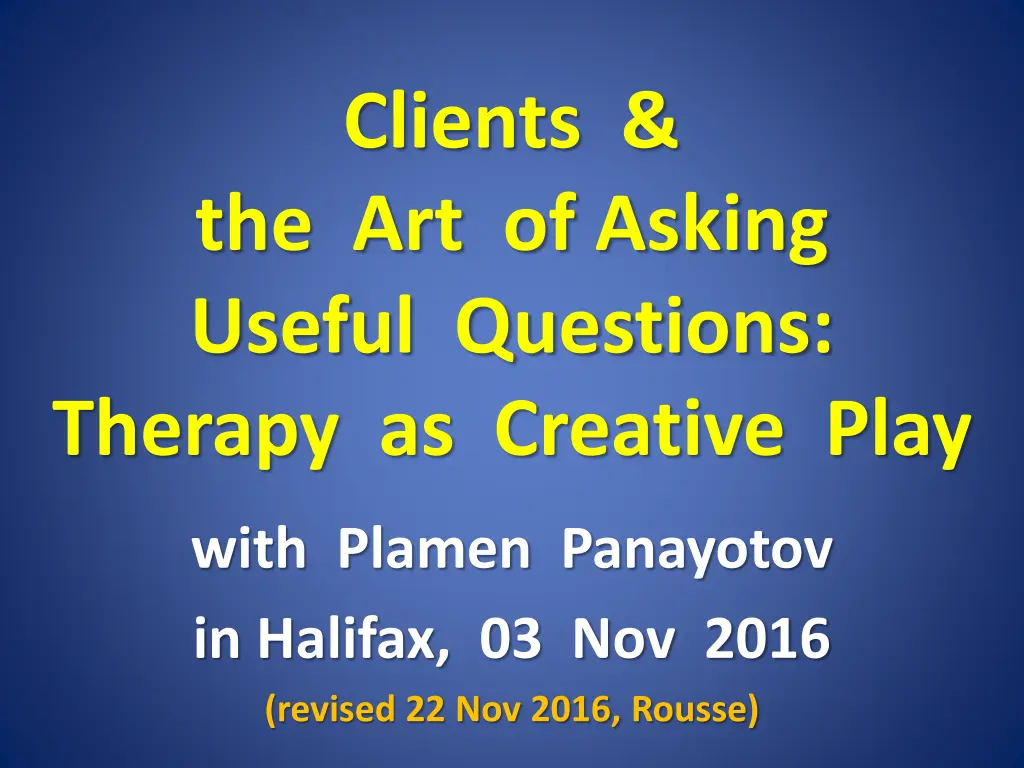
Therapeutic Approach: Enhancing Client Empowerment Through Questioning
Discover how to empower clients through questioning techniques in therapy, enabling them to explore their resources, skills, and habits. Learn about different questioning methods and the importance of engaging clients in the therapeutic conversation to promote self-discovery and personal growth.
Download Presentation

Please find below an Image/Link to download the presentation.
The content on the website is provided AS IS for your information and personal use only. It may not be sold, licensed, or shared on other websites without obtaining consent from the author. If you encounter any issues during the download, it is possible that the publisher has removed the file from their server.
You are allowed to download the files provided on this website for personal or commercial use, subject to the condition that they are used lawfully. All files are the property of their respective owners.
The content on the website is provided AS IS for your information and personal use only. It may not be sold, licensed, or shared on other websites without obtaining consent from the author.
E N D
Presentation Transcript
Clients & the Art of Asking Useful Questions: Therapy as Creative Play with Plamen Panayotov in Halifax, 03 Nov 2016 (revised 22 Nov 2016, Rousse)
Dr. Albert Schweitzer: Each patient carries his own doctor inside him. They come to us not knowing that truth. We are at our best when we give the doctor who resides within each patient a chance to go to work.
Question: How do we give the doctor within each patient the chance to go to work ? Work consists of whatever a body is obliged to do , & Play consists of whatever a body is not obliged to do. Mark Twain
Introduction Empowering of clients: In their own lives: by discovering and stimulating their resources, abilities, skills, useful habits, etc. (SFBT) In the therapeutic conversation itself, here and now, in our own offices: by involving them in asking the questions (ST).
The QUQu approach to therapy: Questioning for Useful Questions The power in a conversation is with the person/s asking the questions. Empowering of clients should mean before and above all giving them the possibility to ask the questions they find most useful and timely for themselves, and consider useful answers to them.
The Time-Orientation Question (Boyan Strahilov, 2016): Would you like me to ask you about your past, present, or future now?
The Multiple-Choice Questioning: I have several questions for you, but I am unsure which one is most appealing for you right now so, can you tell me which one of these questions you would like to answer first:
After the initial and partial empowering of clients with the use of the previous questions, what naturally follows is The Mind-Activating Question: You know, my job is to ask questions, and they need to be as useful as possible in this case for you, so what do you think is the most useful question you can hear from me now?
The Delayed-Answers Questioning: Since this is a very important and difficult question, how much time do you need to arrive at the most useful answer to it?
Each and every clients question has at least three advantages over any therapist s question: 1. It is on the client s own Time. 2. It is stated in the client s own language. 3. With every question the client PRACTICES asking useful question for herself, so she inevitably becomes better and better in this!
Repetitorium: TOQMUQMAQDAQ
From What to How The Time-Orientation Question (Boyan Strahilov, 2016): A asks about the time-direction (verb tense) in which his next question should be sated, according to B, and follows it. The Multiple-Choice Questioning: A proposes several questions B decides which one to answer A proposes several new questions A decides which one to answer - B arrives at a conclusion, confirmed by A The Mind-Activating Question: A sets the stage B asks a question A confirms the question B gives an answer A confirms the answer B asks the next question B arrives at a conclusion A confirms the conclusion The Delayed-Answers Questioning: A sets the stage B asks a question A confirms the question, giving enough Time for B to come to an answer
These developments change HOW conversations are structured, and are Second-Order Changes.
They are "changes in the body of rules governing the structure and internal order of therapeutic conversations .
